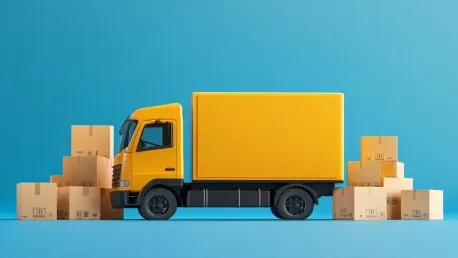The first and last mile delivery market is undergoing rapid transformation, primarily driven by the surge in e-commerce and technological innovations. In 2023, this market was valued at USD 669.99 million and is projected to soar to USD 1,626.70 million by 2030, reflecting a compound annual growth rate (CAGR) of 13.51% from 2024 to 2030. The key stages of first and last mile delivery, involving the transportation of goods from the manufacturer to the distribution center and then to the end consumer, are increasingly critical in ensuring prompt and efficient deliveries, thereby significantly impacting customer satisfaction and operational costs.
Market Drivers
E-Commerce Expansion
The phenomenal rise in online shopping is a primary catalyst for the enhanced demand for first and last mile delivery services. Consumers today expect fast, reliable deliveries, forcing retailers to fine-tune and optimize these segments of their supply chain to meet and exceed consumer demands. The exponential growth of e-commerce has redefined consumer expectations regarding delivery times, pushing for same-day or next-day delivery services. Consequently, retailers are investing in sophisticated logistics technologies and strategies that encompass efficient inventory management and advanced route optimization to reduce delivery times and costs. The integration of robust delivery frameworks has enabled businesses to fulfill orders promptly, thus maintaining high levels of customer satisfaction.
Moreover, the burgeoning popularity of online shopping platforms has multiplied the number of small-scale retailers and e-commerce startups. These enterprises often rely heavily on third-party logistics providers to manage their delivery services efficiently. Increased collaboration between these stakeholders has bolstered the demand for efficient first and last mile delivery solutions, ensuring quick turnaround times from order placement to final delivery. The necessity for reliable delivery mechanisms has prompted even established brands to re-evaluate and overhaul their logistics processes to stay competitive and meet the high delivery standards set by modern consumers.
Technological Advancements
Emerging technological innovations, including route optimization software, real-time tracking, and autonomous delivery vehicles, are streamlining first and last mile deliveries. These advancements not only reduce operational costs but also enhance customer satisfaction by ensuring timely and efficient deliveries. The introduction of route optimization software has revolutionized delivery logistics by enabling real-time analysis and adjustment of routes based on traffic conditions, weather, and other variables. This software ensures that delivery personnel take the most efficient paths, reducing fuel consumption and improving overall delivery speed.
Real-time tracking has also had a significant impact on customer experience, allowing consumers to monitor the progress of their deliveries in real-time. This technology provides transparency and reliability, alleviating the uncertainty associated with waiting for a package. Furthermore, autonomous delivery vehicles, including drones and self-driving trucks, have started making their mark in the industry. These vehicles can navigate complex urban environments and congested areas more efficiently than traditional delivery methods. By utilizing advanced technologies such as machine learning and AI, these autonomous systems can optimize delivery schedules, reduce human error, and ensure precise drop-offs, further pushing the boundaries of what’s possible in the first and last mile delivery sector.
Market Segmentation
By Service Type
The first and last mile delivery market is segmented into B2B (Business-to-Business) and B2C (Business-to-Consumer) services. The B2C segment, in particular, has seen tremendous growth due to the rising e-commerce landscape, necessitating direct deliveries from businesses to consumers. B2B delivery services encompass the transportation of goods between businesses, such as from manufacturers to retailers or distributors. These services often involve bulk shipments and are characterized by larger volumes and fewer drops compared to B2C deliveries. The focus in B2B logistics is on optimizing efficiency in the initial transportation phase, ensuring that goods reach distribution points in a timely and cost-effective manner.
In contrast, B2C services address the final delivery phase, where goods are delivered directly to consumers. This segment has been propelled by the increasing trend of online shopping, where consumers purchase products directly from retailers’ websites or e-commerce platforms. The convenience and accessibility of online shopping have led to a surge in B2C deliveries, necessitating robust last mile logistics solutions. B2C deliveries are often smaller in volume but higher in frequency, requiring logistics providers to manage multiple drop-offs efficiently. The need to cater to diverse consumer preferences and expectations has led to innovative delivery models, including same-day and time-specific deliveries, further intensifying the demand for optimized last mile delivery solutions.
By Vehicle Type
The market features various vehicle types, including light commercial vehicles (LCVs) for inner-city deliveries, heavy commercial vehicles (HCVs) for transporting larger loads over longer distances, and innovative solutions like drones and autonomous vehicles, especially suited for congested urban environments. Light commercial vehicles (LCVs) are predominantly used for last mile deliveries within city limits. Their agility and compact size enable them to maneuver through narrow streets and heavy traffic, making them ideal for urban deliveries. These vehicles typically handle smaller shipment volumes, but their ability to execute quick and frequent drop-offs aligns well with the demands of e-commerce-driven B2C services.
Heavy commercial vehicles (HCVs), on the other hand, are essential for first mile deliveries, transporting bulk shipments over longer distances from manufacturers to distribution centers. These vehicles are designed to handle larger loads efficiently, ensuring that goods are moved in bulk to hubs where they are later sorted for last mile delivery. The combination of LCVs and HCVs creates a comprehensive logistics network that caters to both initial and final delivery phases, maintaining continuity and efficiency across the supply chain.
Innovative delivery solutions such as drones and autonomous vehicles are also gaining traction in the first and last mile delivery market. Drones are particularly useful in addressing delivery challenges in congested urban areas and remote locations. By flying over traffic and other obstacles, drones can ensure quick and precise drop-offs, significantly reducing delivery times. Autonomous vehicles, equipped with cutting-edge AI and navigation systems, offer a promising solution for urban deliveries by reducing the dependence on human drivers and optimizing delivery schedules. These technologies are poised to transform the logistics landscape, offering sustainable and efficient alternatives to traditional delivery methods.
Regional Insights
Asia-Pacific Leads the Pack
In 2023, the Asia-Pacific region seized the largest share of market revenue, thanks to its enormous consumer base and thriving e-commerce sector. This region’s significant growth prospects are further bolstered by the increasing proliferation of online shopping. Countries such as China and India are leading the charge in digital commerce, driven by rapid internet penetration and a growing middle-class population that has embraced online shopping as a norm. The sheer scale of e-commerce activities in these countries necessitates large-scale, efficient first and last mile delivery systems to manage the immense volume of orders generated daily.
Furthermore, the regional governments have undertaken initiatives to enhance infrastructure, support digital transformation, and attract investments in logistics and transportation. These efforts have paved the way for substantial improvements in the delivery network, enabling seamless transportation from manufacturers to consumers. The rising number of online shoppers, coupled with supportive governmental policies, underscores the region’s pivotal role in driving market growth. Companies operating in the Asia-Pacific region are leveraging advanced logistics technologies to meet the burgeoning demand, enhancing efficiency and customer satisfaction.
North America and Europe
North America and Europe are also notable players in this market. North America’s advanced technology adoption and well-established e-commerce industry significantly contribute to market expansion. Meanwhile, Europe is focusing on sustainable delivery solutions, with a rising emphasis on carbon-neutral logistics. North America, particularly the United States and Canada, has observed substantial investments in logistics and transportation technologies, catalyzed by the dominance of major e-commerce platforms like Amazon and Walmart. These companies have pioneered innovative delivery models that prioritize speed, reliability, and customer satisfaction, prompting widespread adoption of cutting-edge logistics solutions.
The region’s technological prowess encompasses real-time tracking systems, automated warehousing, and delivery optimization algorithms that enhance operational efficiency. Additionally, the extensive network of transportation infrastructure supports both first and last mile deliveries, ensuring goods move efficiently across long distances and congested urban areas. Europe’s approach, meanwhile, emphasizes sustainability and environmental responsibility. The region’s progressive policies and consumer awareness towards climate change have led to the adoption of eco-friendly logistics solutions, including electric vehicles (EVs) and carbon-neutral delivery initiatives. Companies in Europe are actively pursuing greener alternatives to reduce the environmental impact of delivery operations, aligning with broader goals of achieving a sustainable future. By integrating renewable energy sources and adopting advanced technologies, Europe is setting a precedent for sustainable logistics that could influence global practices.
Challenges and Future Outlook
Operational Costs and Urban Congestion
Despite the positive growth trajectory, the market faces several challenges, such as high operational costs related to last mile deliveries and urban traffic congestion. These challenges necessitate efficient route optimization solutions to maintain delivery timelines. Urban congestion remains a significant hurdle in last mile logistics, particularly in densely populated cities where delivery vehicles frequently navigate through traffic jams and restricted access zones. These delays can increase operational costs and extend delivery times, adversely affecting customer satisfaction. Efficient route optimization, leveraging AI and machine learning algorithms, can mitigate these issues by identifying the most efficient paths and predicting traffic patterns to avoid congestion.
Another challenge pertains to the high operational costs associated with the last mile delivery, which often entails numerous stops with smaller drop sizes. The cost per delivery unit can escalate due to the intensive labor, fuel consumption, and time invested in making multiple deliveries within city limits. Companies are exploring various strategies to address these cost implications, including micro-fulfillment centers that position inventory closer to consumers, thereby reducing the distance and time required for last mile delivery. By decentralizing inventory storage and leveraging local delivery networks, businesses can effectively lower operational costs and enhance delivery efficiency.
Environmental Impact and Sustainability
The first and last mile delivery market is experiencing a significant transformation, mainly fueled by the rise in e-commerce and advancements in technology. As of 2023, this market was valued at USD 669.99 million and is expected to escalate to USD 1,626.70 million by 2030. This represents a compound annual growth rate (CAGR) of 13.51% from 2024 to 2030. The crucial phases of first and last mile delivery involve transporting goods from the manufacturer to a distribution center, and subsequently from the center to the end consumer. These stages are increasingly vital for ensuring timely and efficient deliveries, which in turn greatly influence customer satisfaction and operational expenses. Heightened customer expectations and the need for faster delivery times are compelling businesses to optimize their supply chain logistics. This shift ensures a seamless transition of goods from production to final delivery, making the entire delivery process more effective and reducing overall costs, while maintaining high levels of customer contentment.









